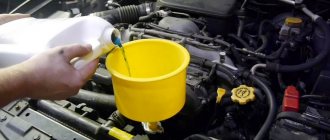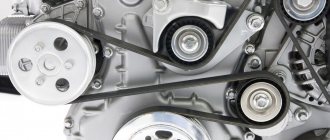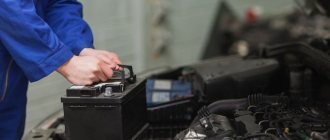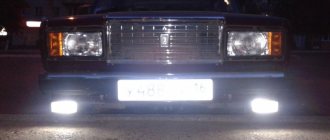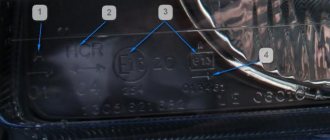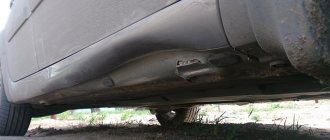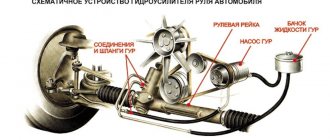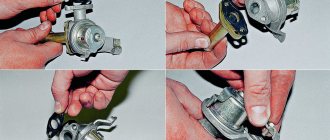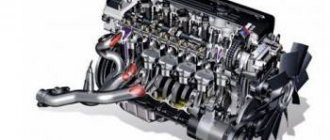Xenon headlights are representatives of the modern generation of automotive optics, which provide high-quality light while minimizing inconvenience for both the motorist and other road users.
Now xenon is installed in both fog lights and main optics, since it performs its functions well.
And the question of how to install xenon low beam on a car in 2019 should be considered so that in the process of selecting and installing equipment there are no problems or even punishment from the traffic police.
General points
Xenon-based headlights are a flask into which xenon gas with impurities of metal chlorides is pumped, and depending on the necessary parameters, the color of the emitted light can change.
Xenon lighting devices are regulated by law, and if they are installed in cars that are not structurally designed for this, then special permission is required, and in the case where xenon is provided, you can simply insert the appropriate bulb into the headlight and adjust it correctly.
Initial data
More recently, xenon headlights could only be found on expensive cars of well-known brands, and even then, in maximum trim levels.
Cheaper cars worked, at best, with halogen lighting, which also made it possible to illuminate the road at night and in difficult weather conditions, but was inferior in quality to xenon.
When gas-discharge lamps became cheaper, Russians began installing them en masse not only in cars designed for this purpose, but also in the optics of old cars, which had a bad effect on road safety, and then the traffic police took measures to limit the use of such light.
Appropriate headlight markings
All headlights that are used in vehicles are distinguished by markings, depending on which you can determine what type of lighting they are intended for, and which bulbs the headlights are limited to using.
Thus, the low beam marking is indicated by the letter C, the high beam by R, while the purpose of the headlight for xenon is marked with the letter D.
As a result, low-range xenon is designated DC, and if a headlight has xenon that can be both high- and low-range, then the letters DCR will be placed on it.
It wouldn’t hurt to familiarize yourself with the markings in order to see the approval code in certain countries, for example, to know whether the optics are certified for Russia.
In Europe, the function of displaying the approval of optics is performed by a circle in which there is the letter E and a number corresponding to the country in which the headlight can be used.
CIS countries are designated by code 22, and if there is one, it means that the traffic police will not have any questions about the use of such lighting.
Photo: types of lamps with markings
Current regulatory framework
There is no specific legislation regarding the use of xenon, but at the same time, there are Vehicle Operating Rules that state that cars must be operated only with the devices that were intended for them.
This applies to both serious parts like the engine or exhaust system, and important little things, including headlights and light bulbs in them. For violating these standards, the driver can be seriously punished administratively.
If illegal xenon headlights are installed in a car, or their adjustment, as well as color, do not meet the requirements for safe operation, then the traffic police inspector who stopped the car can issue a protocol in accordance with Article 12.5 and its paragraph 3, which provides for the deprivation of driving rights as a punishment. period from six months to a year.
True, this requires confirmation of the installed xenon from a technical expert, and the check should be carried out only at stationary traffic police posts that have the necessary equipment.
What problems does it create?
With the xenon law, the authorities were able to improve the situation on the country's roads. The main problem is that the advantages of such headlights pale in comparison to the problems that arise when the equipment is installed incorrectly.
What is the fine for xenon headlights?
The most common 2 cases:
- Reduced visibility. Driving a car can become dangerous if you install xenon bulbs on it, which are incompatible with the existing reflective elements. This is true for cars that did not have xenon installed initially.
- Blinding drivers of cars moving in the oncoming lane. It will be a real miracle not to get into an accident if the xenon has a blinding effect on other road users, causing them to lose control of the vehicle or accidentally crash into the wrecker itself.
If you install xenon in lensed headlights that are designed for this purpose, you will be able to avoid the problems described above. The result will be a clear luminous flux, providing comfortable driving conditions.
Installing xenon low beam
Installing xenon lamps in low beam is not difficult, but you should understand all the little details that accompany the procedure, since even the slightest mistake can cause the headlights to not work correctly and greatly reduce their service life.
Among other things, it is necessary to understand the principle of operation of xenon lighting, since without this information it is impossible to determine how exactly the headlights should be used, and why, for example, they cannot be installed with a high intensity indicator or be equipped with an auto-corrector.
During the process of installing xenon, you need to adhere to certain safety measures, for example, temporarily disconnect the battery when working with wires.
Indeed, if voltage passes through, the technician will experience a strong electric shock, since when lighting a xenon lamp, it requires approximately 23,000 V, which is quite a lot for the human body.
It won't hurt to stock up on a rubber mat and gloves, but it would be best to completely cut off the power to the car.
Preparatory stage
To prepare for installing xenon, you need to stock up on all the tools you will need.
Their list is quite small and consists of:
- a set of xenon equipment (lamps, ignition units and wires);
- drill or screwdriver with a 25 mm drill bit;
- self-tapping screws for fastening, double-sided tape or plastic ties;
- silicone sealant.
As mentioned earlier, you should definitely disconnect the battery for your own safety, as well as maximize access to the rear of the headlights, which are accessible from the engine compartment.
What is better xenon or LED lamps for cars, see the article: what is better xenon or LED.
Read about the markings of headlights for xenon and halogen here.
For example, an air duct or other pipes may interfere with getting to them; they must be removed before the work is completed, so it will be much easier to carry out the xenon installation procedure.
The principle of operation of this optics (instructions)
A xenon lamp consists of a bulb and the gas that is contained in it. It is difficult to name the contents of a light bulb specifically as xenon, since it consists not only of it, but also of chlorides of other metals, the composition of which varies in different types of headlights, as does the filling ratio.
Inside the flask itself there are two electrodes, and when a strong electrical impulse passes through them, the gas begins to glow due to its chemical properties.
Moreover, the peculiarity of near optics is such that it cannot change the direction of radiation and therefore only produces low beam.
If we talk about bi-xenon, then this is the same lamp, but in addition it has a mechanism that consists of a metal curtain and a magnet that changes the direction of light.
In this way, you can switch between near and far operating modes, and the shutter will open different areas of the lamp for this.
Features in choosing a kit
Xenon light kits are a special convenience. They include the light bulbs themselves, ignition units for them, as well as connection equipment, such as wires and terminals.
There is a very wide range of kits on the market that have different prices and, accordingly, quality.
The best xenon kits are considered to be Japanese ones, which have good light and a long service life.
Next come the kits produced in Europe and the USA; they are slightly lower in price, but in terms of lighting they are practically not inferior to the Japanese ones.
At the bottom of this pyramid there are all kinds of Asian manufacturers, whose quality is practically no different from other brands, thanks to complex production technology, but they last an order of magnitude less than expensive options.
All kits are fully compatible in terms of elements, so there is no need to select the base for the block, as is the case when selecting it yourself.
The light bulbs in the set can be of different color temperatures, which determines the color of the lighting.
For example, light bulbs in the range of 3000-4000 K give a yellow color, similar to halogen headlights, but 4000-5000 K already provide a pure white color with possible impurities of a milky tint.
They are the most similar to daylight and are comfortable for the eyes, therefore they are most often used by car manufacturers for equipment.
Anything higher is less effective and at the same time discolors the surrounding objects, moreover, having a tint of blue or purple, which, if installed illegally, will certainly attract the attention of a traffic police inspector.
How to connect it yourself
After the battery is disconnected for safety, you need to dismantle the headlight and remove the plug from it. The power is turned off from the halogen lamp, and the lighting element itself is removed from the device.
Using a drill, a hole is made in the protective cover through which the lamp power wire is pulled; there is also a ring on it that secures the wire in the hole, but to be sure, you can add sealant.
Next, a new lamp is installed, the bulb of which must never be touched, and if this happens, it should be degreased with alcohol.
Xenon is connected to the power wires, observing polarity, after which the headlight is closed.
The wires from the lamp are connected to the ignition unit, and it itself is attached under the hood as close to the headlight as possible; a click should be heard when connected.
The ignition unit is connected to the standard electrical system, after which xenon is also mounted on the second headlight and adjustments are made.
Video: low beam headlights
The reason why he blinks
If the xenon blinks in the first seconds after turning on the headlights, this is a completely normal phenomenon associated with the heating of the gas, but if it continues further, measures need to be taken.
If the problem is in one lamp, then you need to try swapping it with another; if another lamp blinks in the same place, then the problem is in the ignition unit, and when the rearranged lamp works with defects, then the cause of the breakdown is in it.
The problem may also be in the wires, which must be well insulated, and if the insulation is broken, then blinking may occur upon contact with metal.
When the cause is identified, you need to replace the faulty elements, in pairs, since they are connected to each other, after which you can continue to use xenon.
Pros and cons of LED lighting
Xenon light has a lot of pros and cons, thanks to which some drivers love it and constantly use it, while other motorists choose halogen or LEDs:
| So, the positive aspects include: |
|
| But there are also certain negative features: |
|
Which xenon is better 4300 or 5000 in PTF
If you want to know how to restore your rights if lost, read here.
Is it possible to check your license using the traffic police database, see here.
Installing xenon in the low beam of a car is a procedure that will significantly improve the visibility of the driver of the car in different conditions, be it darkness or fog, or pouring rain.
But at the same time, you need to choose the right equipment, use it only with certificates and in approved headlights, and also make precise adjustments, because unadjusted xenon is very dangerous for road users.
Xenon headlights are characterized by bright light, high power, low energy consumption and long service life. But you can’t always put them on, and not for everyone. The law prohibits self-installation of such headlights.
If they are included in the basic configuration of the car or xenon installation is provided according to factory specifications, then the driver will not break the law.
In other cases, you can lose your rights for up to a year. What headlights are allowed to install xenon?
Is it possible to legalize installed xenon
An inspector has the right to check the compliance of lighting devices at a stationary or mobile point where the appropriate equipment is available. However, the person has the right to apply penalties and confiscate the certificate only after a decision of the judicial authority that sent the verdict to the traffic police department.
Having tacitly installed emitters, the vehicle owner has the right to legitimize them. After making changes to the technical passport and checking the design innovation with the help of an official service station inspector, the car can use high-glow headlights. This will be preceded by a visit to a specialized organization to obtain permission to install them and undergo a special examination. True, the latter is paid, its cost is 4 thousand rubles.
An official written application indicating:
- full personal formula of the head of the organization;
- place of registration, personal formula of the applicant;
- brands, models of structural elements;
- technical passport details;
- proposed changes, the name of the installed lighting device, its brand.
Typically, such requests do not remain for a long time and must be signed almost instantly. You should also prepare thoroughly for a trip to the traffic police department.
You need to collect the required documents:
- Passport.
- Technical passport of the product.
- Certificate of vehicle registration.
- Original preliminary report.
The traffic police, based on the submitted documents, will issue a conclusion on the work:
- vehicle data;
- possible modification;
- description of upcoming work to properly change the design of lighting devices.
After the changes have been made, the official technical inspection inspector will issue a document confirming the installation of gas-discharge lighting devices on the vehicle.
After receiving it, the driver is no longer afraid of any administrative liability. Of course, it doesn’t make sense to carry this permission with you all the time, so the owner is expected to take just a couple of steps:
- Submission of the mentioned document to the traffic police department indicating the changes made.
- Payment of state tax for entering information into the vehicle passport.
The procedure for making changes takes no more than one hour, after which a record about the conversion of lighting devices for gas-discharge lighting will appear in the “special notes” line.
List of legally permitted headlights for installation
Xenon can be installed in those headlights that are equipped for this type of light source. You can't just install xenon headlights - it's illegal.
This rule is explained by the fact that when installed illegally, the bright light blinds drivers and violates road safety.
The legislation establishes the types of headlights in which xenon can be installed.
They carry special markings:
| DR and DC | means that the car has high and low beam headlights. Installation of xenon is allowed in any of them. Installation in both headlights is also allowed |
| DCR | This marking is found on cars that are equipped with one lamp that works for both low and high beam (so-called dual-mode headlights). Installation of xenon is not prohibited |
| HR and DC | The marking indicates that it is prohibited to install xenon in the high beam, but it is allowed in the low beam |
| HR and HC | This marking is found on the headlights of Japanese cars. In this case, xenon can be installed. If the marking is affixed to a car manufactured in another country, then only halogen headlights are allowed. |
You can remember an easier rule: if the letter D is on the label, then halogen is allowed. Vehicle registration certificate? In other cases, you will have to be content with a halogen or incandescent lamp.
You can obtain information about the possibility of installing xenon headlights from the manufacturer or an official dealer of the brand under which the car is manufactured.
But submitting a request takes a lot of time, so it’s best to familiarize yourself with the labeling. If necessary (for example, you have difficulty finding the treasured letters), you can contact any service station.
Installation of gas-discharge headlights with the following markings is not allowed:
| HC and HR | means that only halogen lamps can be installed on the car |
| HCR | The marking indicates that the vehicle has one lamp for high and low beam. Xenon is prohibited in such cars |
| CR | cars that can only install incandescent lamps |
Other types of headlights are prohibited.
Many car owners believe that if xenon headlights were purchased from a prestigious company and not from the Chinese market, then their installation is legal.
In fact, the brand and model of xenon does not matter. The possibility of installing such headlights is provided by manufacturers, so any xenons, regardless of cost, are prohibited.
A selection for you!
Download forms and sample documents for motorists to a safe place.
Why is xenon in demand?
The emergence of innovative technologies is also reflected in the automotive industry. One of these was the discovery of the inert gas xenon. The substance is actively used in new generation lighting devices. Comparing old lighting methods with xenon, we can safely say that the palm belongs to the latter.
A noble gas of increased inertness has a different ability to cause luminescence than the substances that fill incandescent lamps.
In addition, threads are characterized by:
- fragility;
- cliffs.
These qualities appear even with slight shaking of the lamp. Therefore, frequent off-road trips reduce the operating time of such devices, threatening to leave the driver in complete darkness.
The gas substance ignites due to the difference in potentials applied to the electrode bulb. The absence of a thread prevents damage to the xenon flashlight from impacts and shaking, since there is nothing to break in it. Having received an electrical discharge, the gas maintains its glow at only 35 W. This, first of all, indicates the durability of the lamp.
Where to find the markings
The location of the markings depends on the car model and the type of headlights. Most often numbers and letters are located on the headlight glass
Or on top of the headlights. To do this you will need to open the hood.
But in some headlights the markings are located on the inside, so you will have to completely remove the lighting fixture.
The marking looks like this:
What do the numbers mean:
- Headlight type.
- Type of lamps used.
- Mark of compliance with international standards. The number next to the letter designation is the country of manufacture code.
- Type of headlights according to type of traffic (left-hand, right-hand).
When determining which headlights can be equipped with xenon on a VAZ and cars of other brands, you should pay attention to the letter designation under the number “2”.
What xenon is is explained in the article: xenon.
Which xenon lights up better, read here.
Xenon and bi-xenon
Bi-xenon is the name given to headlights that can shine not only in the “low” beam of the headlights, but also in the “high beam”. The bi-xenon module is installed on cars that have one light with two filaments, responsible for both the “low” beam and the “high beam” (type H4).
During the operation of the H4 halogen lamp, when one filament is turned on, the “low” beam works, when the second thread is turned on, the “high” light works.
Due to the impossibility of providing exactly the same principle of operation of a xenon lamp (building two xenon bulbs into one light bulb at once), the bi-xenon module has only one light source, which moves inside the module, thereby ensuring the inclusion of “low” or “high” beam ( in some modules it is not the light bulb that moves, but a special “curtain”).
What is unacceptable when installing xenon headlights
Installation of xenon headlights must be carried out according to the following rules:
- Before starting work, it is important to check all parts for damage. If the equipment has chips, scratches or other signs of xenon malfunction, installation cannot be continued. You need to contact the manufacturer to replace parts.
- Installation should only be done with clean and dry hands. Otherwise, you may receive a severe electric shock.
- All connections must be securely hidden and insulated. It is necessary to protect them from external influences and moisture.
- You should not look at the light rays from xenon for a long time - this can lead to vision impairment.
- For the first time, you need to start xenon with extreme caution. If safety precautions are not followed, you may receive an electric shock with a power of 23 thousand volts.
- Before starting installation, you must disconnect the positive terminal of the battery. This will eliminate the possibility of electric shock.
If you install it yourself, you must follow the instructions. But it is important to understand that the technical structure of all cars is different.
Therefore, it is better to contact a car repair shop, where specialists, even for a fee, will do their work quickly and competently, without damaging the internal components of the car.
It is not allowed to install xenon without the accompanying equipment. If you did not purchase a complete set of parts, then it is better to postpone installation for a while. So, xenon requires additional installation of an auto-corrector.
It adjusts the direction of light when driving on uneven roads, a full trunk, or carrying a large number of passengers.
In these cases, there is an overweight and the headlights have an incorrect angle, blinding oncoming drivers.
Where can you install xenon on a car?
The configuration of previously produced cars did not provide for the installation of gas-discharge lamps. Therefore, the latter cannot be mounted in headlights, rear and fog lights. Ignoring the rules will be punishable by fines when the car is stopped by the traffic police.
The designs of new cars provide for the modification of halogen lamps with xenon lamps.
This is facilitated by legislation that allows the installation of lamps with the following markings of devices:
- DC - low beam.
- DR - distant.
- DCR - combined.
Initially, gas-discharge sources were allowed to be used for long-distance lighting. At close range they blinded oncoming drivers. Now, automatic units that regulate light emission allow use in low beam. Such low beam lights reduce the cost of the machine and the economic costs of lighting. Modern foreign cars are mostly equipped with similar emitters.
Responsibility for violations
Lately, law enforcement officials have been keeping a very close eye on the headlights installed in cars. Xenon causes terrible accidents on the roads, so their illegal installation threatens serious liability.
Many drivers offer bribes to traffic police officers, which further aggravates the situation. Of course, a greedy inspector may agree to turn a blind eye to a violation when he sees a pink bill, but it is important to understand that giving a bribe is a criminal offense.
Punishment is provided for those drivers who have installed xenon headlights on a car that are adapted for halogen headlights or incandescent lamps.
It is not difficult to determine the violation, especially in the dark, when bright white light illuminates the road well.
According to the Code of Administrative Offences, there are two penalties for the illegal installation of xenon:
- Deprivation of a driver's license for a period of 6 months to 1 year.
- Confiscation of equipment that is used illegally by the car owner. Xenon is confiscated from the driver and cannot be returned.
It does not matter who was driving the car - the driver allowed to drive the car under compulsory motor liability insurance or the owner.
The first one will be deprived of his license and the equipment will be confiscated. The owner will be able to use the car without restrictions, provided that the lamps are replaced.
According to the law, illegal installation of halogen is equivalent to operating a knowingly faulty car. And this is a fairly serious violation for which there is not even a fine.
It turns out that the driver is driving a car that, according to its technical parameters, is not suitable for driving.
Traffic police inspectors have the right to check the legality of installed xenon headlights on any section of the road where stopping is permitted. The driver may be asked to open the hood and even remove the headlight.
The situation becomes more complicated if illegally installed xenon led to accidents and casualties. In this case, the driver falls under criminal liability and is imprisoned for up to 8 years.
It will be almost impossible to prove your innocence, since as a result of the examination it will become clear what was the true cause of the accident.
In general, xenon has many positive aspects. It produces a bright, eye-pleasing light, improving visibility on the road.
But it can only be installed in those cars that have the ability to install xenon.
In other cases, the use of such headlights is considered illegal, for which punishment is provided in the form of deprivation of the license.
You should not use xenon where it is unacceptable. It is important not only to take care of yourself, but also to follow the rules of safe driving on the roads.
How to legalize xenon for a foreign car is described in the article: how to legalize xenon.
Why xenon lights up in different colors, see the page.
Find out about xenon installation in Moscow from this information.
Is it possible to avoid a fine for illegal installation?
It is almost impossible not to notice the xenon light from the car. Especially when we are talking about an old domestic car. In such cases, almost everyone will have to answer for xenon lamps. You can avoid punishment in a rather banal way - by making it difficult for the inspector to work.
Several steps will help:
- Requirement to present identification, video recording or presence of witnesses.
- Reminder that a claim for damages will be filed for damage during inspection.
- Words about how you don’t have the skills to unscrew light bulbs, but you don’t want to break them.
If the car is under warranty, then no traffic violations allow the warranty seals to be broken, which is also allowed to be invoked. Additionally, we can say that the headlights do not work if we are talking about fog lights, or halogen lamps, but with a cold tint.
An experienced lawyer will help in court to avoid deprivation of rights and change the punishment to a fine of 500 rubles if, when drawing up a report, the driver indicates disagreement with the inspector. It will be difficult to achieve such a result. However, under certain circumstances it is possible.
Important! Xenon 4300 K is the optimal choice in all respects; it is practically indistinguishable from halogen.
General points
A feature of headlights with lenses is that the flow of light is “cut”, due to which the direction is adjusted. The rays pass only along the horizon and are not transmitted vertically.
The design of headlights with lenses consists of separate blocks. This:
- headlight itself;
- reflector;
- xenon lamp.
The lens is used to focus a beam of light directly onto the road, and this is its main function. Vehicle registration certificate? Using headlights without lenses is considered illegal.
To ensure that the beam of light is cut strictly vertically, special magnetic “curtains” are used. It is possible to install automatic headlight adjustment.
Initial data
Installation of lensed xenon in standard headlights can be done independently, but most modern cars have a similar design at the exit from the production workshop.
Drivers resort to such tricks in order to improve the appearance of the car and its performance, or to achieve high-quality lighting.
Pros of using lensed headlights:
- increasing the factory characteristics of the vehicle;
- improving the appearance, “tuning” the car;
- high functionality and durability.
However, it should be noted that there are also disadvantages. Installing lenses with xenon lamps in artisanal conditions is considered illegal.
After the lamps are installed, they need to be adjusted correctly. You should entrust the work of installing headlights and lenses to an experienced car service technician.
Why is it installed?
Drivers resort to installing xenon lamps for several reasons:
| For vehicle tuning | Xenon headlights look beautiful, and when installing lenses you can get the effect of “angel eyes” - a rim of LEDs is installed around the lens. It should be noted that tuning is possible using halogen lamps |
| Improved luminous flux | Lenses can be installed together with xenon lamps. As a rule, installation is carried out at special repair stations that have a certificate. Xenon lamps are supplied complete with lenses |
| Factory settings and lamp replacement | On some car models, lenses with lamps are installed at the factory as standard. As a rule, these car models are very expensive, as is a separate package for them. Headlights in modern cars are separate computer systems that have many functions - turning lights, changing the angle of illumination |
The main reason why drivers resort to installing lamps is tuning and improving the appearance of the car.
However, if only tuning is required, you can install lenses on the car on halogen lamps. The luminous flux in this case does not improve.
The use of lenses still allows for the focusing of light, due to which it is directed to certain areas of the road.
Often, drivers install lenses with “angel eyes”. It should be borne in mind that lensed optics are not only a decoration for a car. It is necessary to install lamps with lenses to improve any characteristics.
Car service technicians offer a choice - installing lenses with halogen or xenon. The second option is the most preferable due to the fact that the glow of xenon lamps is stronger, especially if a headlight with a reflector is used.
When purchasing a car from the factory, you should take into account that lensed optics are not included in the basic versions and are used only in the maximum configuration of the car.
In addition, factory cars most often have halogen lamps with lenses, which allows the light beams to be focused.
Installing lenses requires serious equipment. In addition to the lenses themselves, the headlight must contain sensors, the operation of which allows you to automatically adjust the angle of light.
This is a safety requirement, and violating it is comparable to violating the law and traffic rules. This equipment is very expensive, so it is used only in cars with the maximum configuration.
What is regulated
Any unauthorized changes to the design of car headlights are considered illegal.
A traffic police officer has the right to remove such headlights, and the driver will have problems when passing a technical inspection.
To obtain permission to install headlights, you should contact a certified organization. Please note that you may need permission from the traffic police and a complete replacement of the headlights.
Regulatory acts:
- UNECE Regulation No. 99.
- Code of Administrative Offenses - Federal Law No. 195. Article 12.5.
- GOST standard R.41.99 - 99.
- Explanations of the Department for Road Safety dated February 20, 2010 “On the use of xenon headlights.”
These regulations are applied by both drivers and traffic police officers who check cars and seize headlights.
What is xenon, why is it installed?
Xenon is the common name for gas-discharge lamps in which an electric arc glows in a bulb filled with gas - xenon.
This source produces bright white light, close to daylight. Xenon lamps do not have a filament like halogen lamps. An electric arc occurs between two electrodes. To ignite the arc, it is necessary to generate high-voltage (up to 25,000 V) voltage pulses. Therefore, to “ignite” such a lamp, a special control unit is used, which increases the voltage when the headlights with xenon lamps are turned on. After the lamp is lit, a nominal voltage of up to 80 V is sufficient to maintain the discharge.
Difficulty of installation
The third serious disadvantage of installing xenon lamps in “halogen headlights” is the certain difficulty of installing them on a car that does not have special places for this.
Since each xenon lamp has its own high-voltage “ignition unit”, which must be placed next to the headlight, xenon installers do not think much about where exactly to place it and place it “somehow”, often leaving entire bundles of wires “dangling freely”.
Such placement of electrical wiring in the engine compartment, where oil or fuel leaks may well appear, is very dangerous. High voltage electrical connections can cause a spark, which in turn can easily lead to a fire.


